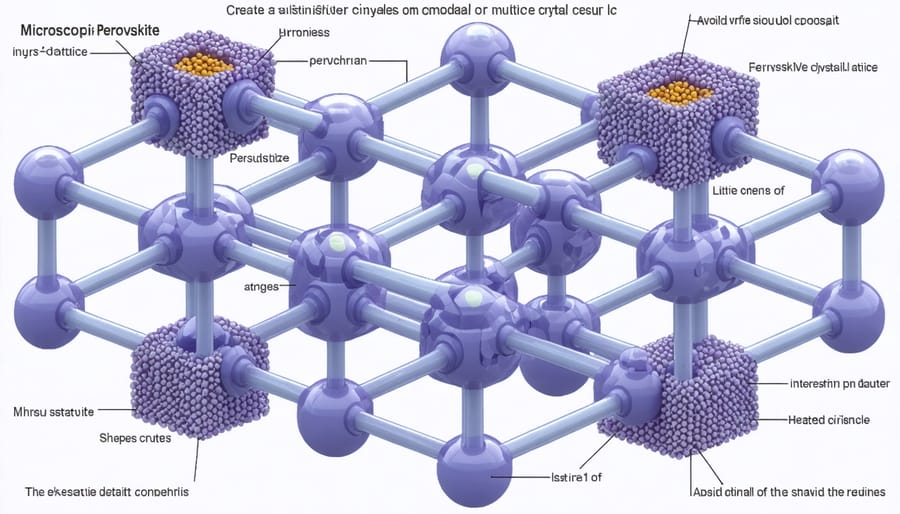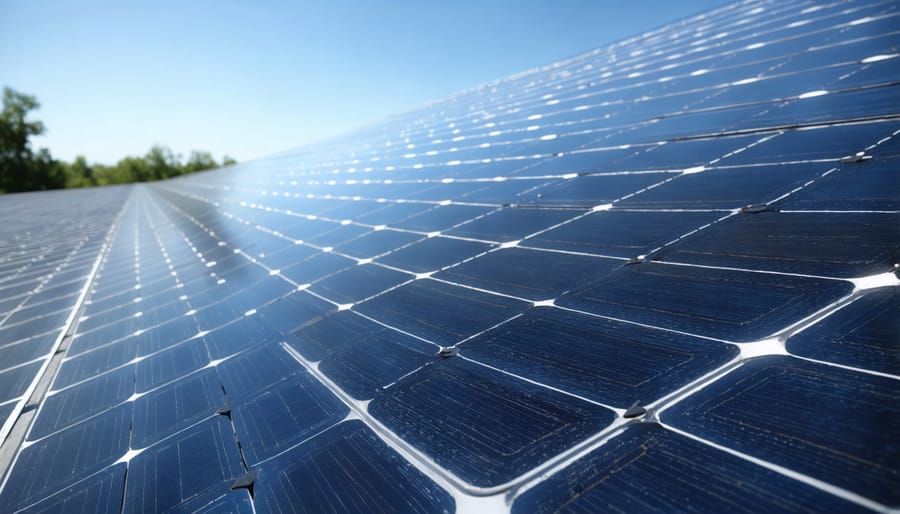These Revolutionary Solar Materials Are Transforming European Construction

Breakthrough materials are revolutionising solar panel technology across Europe, promising to transform how we harness solar energy. From perovskite-silicon tandems achieving record-breaking 31.25% efficiency to ultra-thin copper indium gallium selenide (CIGS) films that can be integrated into building materials, these innovations mark a significant shift in renewable energy capabilities. Advanced polymer-based panels, notably those incorporating carbon nanotubes and quantum dots, are delivering exceptional performance while reducing manufacturing costs by up to 40%.
European manufacturers are leading this materials revolution, developing solutions that specifically address the continent’s diverse climate conditions and strict building regulations. These next-generation materials not only enhance energy capture in low-light conditions—crucial for Northern European markets—but also offer unprecedented flexibility in architectural integration. Property developers and construction professionals can now choose from a range of aesthetically pleasing, high-performance options that comply with the EU’s ambitious 2030 renewable energy targets while maintaining building aesthetic integrity.
Perovskite Solar Cells: The Next Generation of Solar Technology
Why Perovskites Are Revolutionary
Perovskite solar cells represent a groundbreaking advancement in photovoltaic technology, revolutionizing how we approach solar energy generation. Unlike traditional silicon-based essential solar panel components, perovskite materials offer remarkable flexibility in both physical form and manufacturing processes. These innovative materials can achieve impressive power conversion efficiencies exceeding 25%, approaching the performance of conventional silicon cells while requiring significantly less material and energy to produce.
What makes perovskites particularly revolutionary is their ability to be manufactured using simple solution-based processes at relatively low temperatures. This translates to reduced production costs and lower environmental impact during manufacturing. Additionally, perovskites can be tuned to capture different parts of the solar spectrum effectively, making them ideal for creating multi-layer cells that harvest more energy from sunlight.
For European markets, perovskite technology promises to deliver more efficient and cost-effective solar solutions, particularly in regions with variable weather conditions. Their superior performance in diffuse light conditions makes them especially valuable for northern European installations.

European Implementation Progress
Across Europe, the implementation of new solar panel materials has gained significant momentum through various large-scale initiatives. The European Solar Innovation Alliance, launched in 2022, has successfully deployed perovskite-silicon tandem cells in pilot projects across Spain and Germany, achieving efficiency rates of up to 29.8%.
In the Netherlands, researchers at Delft University of Technology are advancing the development of transparent solar cells, with real-world applications already visible in greenhouse installations. Meanwhile, Swedish innovators have pioneered temperature-resistant polymer materials that enhance solar panel durability in extreme weather conditions.
France’s Solar Valley project has established a testing facility for new photovoltaic materials, focusing on bifacial solar technology and advanced coating solutions. The facility has supported over 50 companies in validating their innovations under real-world conditions.
The European Union’s Horizon Europe program continues to fund breakthrough research, with €320 million allocated specifically for next-generation solar materials development between 2021-2024. This investment has already yielded promising results in quantum dot solar cells and organic photovoltaic materials, positioning Europe at the forefront of sustainable energy innovation.
Building-Integrated Photovoltaic Materials
Solar Glass Innovations
Recent breakthroughs in solar glass technology are revolutionizing how we approach integrating solar into buildings. Transparent solar glass, featuring advanced photovoltaic materials embedded within the glazing layers, enables windows to generate electricity while maintaining their primary function. These innovative solutions achieve transparency levels between 20% and 50% while converting solar energy with efficiency rates of 5-12%.
European manufacturers have developed specially treated glass that incorporates luminescent solar concentrators (LSCs), which redirect incoming sunlight to the edges where small solar cells harvest the energy. This technology is particularly valuable for office buildings and commercial spaces where traditional solar panels might not be suitable.
Semi-transparent perovskite solar glass represents another significant advancement, offering improved efficiency while maintaining aesthetic appeal. These materials can be manufactured in various tints and colours, allowing architects to maintain design flexibility while embracing sustainable energy solutions.
The latest generation of solar glass also features self-cleaning coatings and enhanced durability, ensuring long-term performance in various weather conditions. With installation costs decreasing and efficiency continuing to improve, these innovations are making solar glass an increasingly attractive option for sustainable architecture across Europe.

Solar Tiles and Roofing Materials
The integration of solar technology into building materials has revolutionized how we think about roofing solutions. Solar tiles, also known as photovoltaic shingles, represent a significant advancement in building-integrated photovoltaics (BIPV). These innovative materials seamlessly combine traditional roofing functionality with solar power generation capabilities, offering a more aesthetically pleasing alternative to conventional solar panels.
Recent developments have introduced solar tiles that mirror the appearance of traditional slate, terracotta, and concrete roofing materials while achieving conversion efficiencies of up to 20%. European manufacturers have made substantial progress in developing weather-resistant coatings that enhance durability and performance in varied climate conditions.
Notable innovations include transparent solar tiles that allow natural light penetration while generating electricity, and modular systems that simplify installation and maintenance. These solutions are particularly relevant for heritage buildings and areas with strict architectural guidelines, as they preserve the visual character of structures while adding renewable energy capabilities.
The market now offers various options, from complete solar roof systems to hybrid solutions that combine conventional tiles with solar elements. These products comply with European building regulations and often qualify for regional sustainability incentives, making them increasingly attractive for both residential and commercial applications.
Organic Photovoltaic Materials
Flexibility in Design
Modern solar materials offer unprecedented design flexibility, enabling seamless integration into diverse architectural projects. Thanks to innovative thin-film technologies and flexible substrates, solar panels can now conform to curved surfaces, irregular shapes, and even transparent elements. This adaptability proves particularly valuable in Europe’s varied architectural landscape, where historical preservation often meets modern sustainability requirements.
For renovation projects, lightweight and flexible solar materials can be applied to existing structures without compromising their structural integrity. In new construction, architects can incorporate solar elements as building-integrated photovoltaics (BIPV), replacing traditional building materials with power-generating alternatives. These versatile materials serve multiple functions – from solar roof tiles that maintain aesthetic appeal to semi-transparent solar windows that generate power while allowing natural light transmission.
The flexibility extends beyond physical adaptability to installation options, making solar integration possible in previously challenging locations. This versatility opens new possibilities for urban solar deployment, particularly in space-constrained European cities.

Environmental Benefits
The latest advancements in solar panel materials bring significant environmental advantages beyond clean energy generation. New materials require less energy during manufacturing, reducing the carbon footprint of production by up to 30% compared to conventional panels. These innovative materials are designed with sustainability in mind, featuring reduced use of rare earth elements and toxic compounds traditionally found in solar technology.
Particularly promising is the enhanced recyclability of these new materials. Modern solar panels are being developed with easily separable components, allowing for more efficient end-of-life processing. This characteristic addresses one of the industry’s biggest challenges: waste management. European recycling facilities can now recover up to 95% of certain new materials, creating a more circular economy in the solar sector.
Additionally, these materials demonstrate improved durability, extending panel lifespan by several years. This longevity reduces replacement frequency and associated environmental impacts, while their higher efficiency means less land use for equivalent power generation.
Installation and Integration Considerations
When integrating new solar materials into construction projects, proper planning and execution are crucial for optimal performance. Before proceeding with installation, consult comprehensive solar panel installation guidelines specific to your region and the chosen material type.
For perovskite-based panels, special attention must be paid to weatherproofing and environmental protection due to their current sensitivity to moisture. Installation should ideally occur during dry weather conditions, and additional protective layers may be necessary. These panels are typically lighter than traditional silicon modules, which can simplify mounting but may require different support structures.
Bifacial solar materials demand careful consideration of surface reflectivity below the installation. Light-colored roofing materials or specialized reflective surfaces can enhance their performance by up to 30%. Mounting height and tilt angles need optimization to maximize exposure to both direct and reflected sunlight.
Organic photovoltaic (OPV) materials offer unique flexibility in installation methods. Their lightweight nature allows for integration into curved surfaces and non-traditional mounting locations. However, proper ventilation systems are essential to prevent heat buildup, which can affect their efficiency.
When working with any new solar material, ensure:
– Compliance with local building codes and regulations
– Proper structural assessment of the installation site
– Compatible mounting systems designed for specific material types
– Adequate spacing for ventilation and maintenance access
– Professional electrical integration with existing systems
– Implementation of appropriate monitoring systems
For optimal results, work with certified installers who have experience with these innovative materials. Regular maintenance schedules should be established according to manufacturer specifications, and monitoring systems should be implemented to track performance and identify any potential issues early on.
The emergence of innovative solar panel materials marks a transformative moment in European sustainable construction. These advancements promise to reshape how we approach building integration of solar technology, offering unprecedented flexibility in design while maintaining high energy efficiency standards. The combination of perovskite cells, transparent solar materials, and enhanced silicon technologies positions Europe at the forefront of sustainable building innovation.
For property owners and developers across Europe, these new materials represent more than just technological progress – they offer practical solutions to long-standing challenges in solar integration. The improved aesthetics and versatility of modern solar materials make them increasingly attractive for both residential and commercial applications, while their enhanced efficiency helps meet stringent European energy performance requirements.
Looking ahead, these materials will play a crucial role in achieving the EU’s renewable energy targets and supporting the continent’s transition to carbon-neutral construction. As manufacturing scales up and costs continue to decrease, we can expect to see widespread adoption of these innovative materials, transforming Europe’s built environment into a network of energy-generating structures. This evolution in solar technology not only supports environmental sustainability but also promotes energy independence and economic growth across the European construction sector.
Leave a Reply